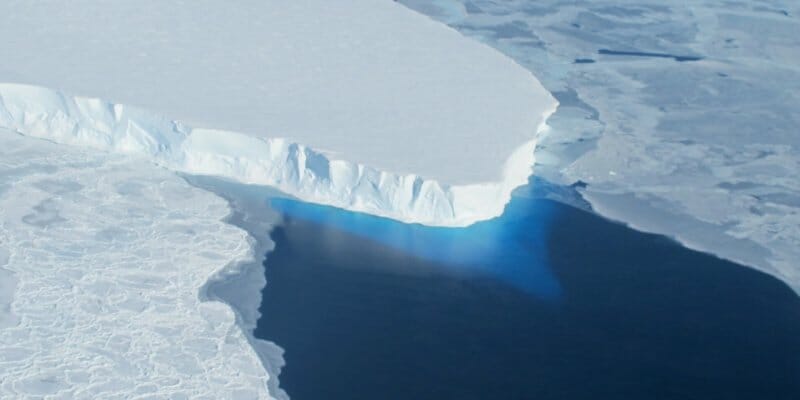As Sea Levels Rise, Do We Invest in Underwater Walls or Retreat Inland?
Scientists grapple with whether a vast submarine wall in front of an unstable glacier could prevent dangerous sea level rise or everyone should just move away from coastal areas. The calving front of the Thwaites ice shelf in Antarctica. (NASA ICE/ James Yungel / Wikimedia Commons)
The calving front of the Thwaites ice shelf in Antarctica. (NASA ICE/ James Yungel / Wikimedia Commons)
Two climate scientists believe they have a long-term solution to the dangerous rise of sea levels by targeting the most vulnerable glaciers, especially those that could trigger a massive collapse of the ice sheets behind them.
A submarine wall big enough and wide enough could halt the flow of increasingly warm ocean water below the front of each glacier. The combination of warmer air temperatures and warmer waters that accompany human-triggered climate change is dangerous: it could for instance accelerate the already alarming retreat of the Thwaites Glacier in West Antarctica, which alone shores up enough ice to raise global sea levels by up to 3 metres.
The scientists don’t propose an immediate start. But they do want to explore ways of halting sea level rise driven by global warming that could soon be costing the world $50 trillion a year in economic losses, that could submerge small island states and turn 1 million people a year into climate migrants.
“We are not advocating that glacial geoengineering be attempted any time soon,” they warn in the journal The Cryosphere.
Their simplest option – a series of pillars to shore up a targeted glacier and keep it “grounded” – would require engineering comparable in scale to the excavation of the Suez canal, would be undertaken in the world’s harshest environment, and would have just a one in three chance of success.
“In the long run we need plans to deal with the committed climate changes that are already in the pipeline, one of which may be an ice sheet collapse”
The researchers – John Moore, of Beijing Normal University in China, who also holds a post at the University of Lapland in Finland, and Michael Wolovick, of Princeton University in the U.S. – have made this case before: they and others argued in March in Nature for what they call “managed collapse.”
In the latest study, they look at the challenge in greater detail. And they warn that even if targeted geoengineering of individual glaciers worked, it would only do so if humans stopped tipping ever more greenhouse gases into the atmosphere to fuel yet more global warming.
Nor do they argue that a submarine curtain wall to halt warming water across the front of the Thwaites glacier – up to 100 kms wide – is currently feasible. “But in the long run we need plans to deal with the committed climate changes that are already in the pipeline, one of which may be an ice sheet collapse.”
And one of these is the Thwaites Glacier in Antarctica: another is the Jakobshaven Isbrae in Greenland. Both could be cases of what the scientists call marine ice sheet instability: as a glacier retreats from its grounding line, the ice lifts off the bedrock and begins to float.
If the bedrock slopes down towards the centre of the ice sheet, and warmer ocean currents wash beneath it, then the ice starts to stretch and thin, and retreat further. At some point, it would become much easier for thawing ice to flow into the sea, and start what could become a runaway collapse. Engineers could devise a way of slowing or halting the process.
Huge impact
The scientists argue that even a rise of 0.6m to 1.2 metres by 2100 could cause up to $50 trillion in economic damage, and the resultant flooding could force up to 200 million to 500 million people out of their homes at least for a few days or weeks: around a million or so every year would never go back.
Climate scientists have been arguing about geoengineering solutions – the so-called technofix – to climate change for more than a decade. Global answers, such as blocking sunlight with stratospheric soot and sulphate aerosols, or whitening the polar ice to make it more reflective, remain contentious.
But the Cryosphere proposals are much more limited, and the immediate dangers of sea level rise are not contested. Ice sheet collapse in Antarctica, for instance, could raise sea levels by more than 3 metres and even by as much as 19 metres over the next two or three centuries.
The researchers’ calculations suggest that in theory an engineering solution that blocked even 50% of the warm water getting under a glacier could offer a 70% chance of delaying or stopping ice sheet collapse.
Left behind
Countries already spend on coastal protection: their solution would require international co-operation at the highest political level, and intensive scientific research.
“Managing sea level rise at the source has the advantage of benefiting the entire world, while a strategy that relies only on local coastal protection is more of an every-nation-for-itself approach that may leave many poor countries behind,” they write.
“Perhaps, after careful consideration, we may conclude that glacial geoengineering is unworkable and the right answer is to invest heavily in coastal protection and retreat inland where that is not practical or economical.
“However, we owe it to the 400 million people who live within 5m of sea level to at least consider the alternatives.”
Your support matters…Independent journalism is under threat and overshadowed by heavily funded mainstream media.
You can help level the playing field. Become a member.
Your tax-deductible contribution keeps us digging beneath the headlines to give you thought-provoking, investigative reporting and analysis that unearths what's really happening- without compromise.
Give today to support our courageous, independent journalists.






You need to be a supporter to comment.
There are currently no responses to this article.
Be the first to respond.